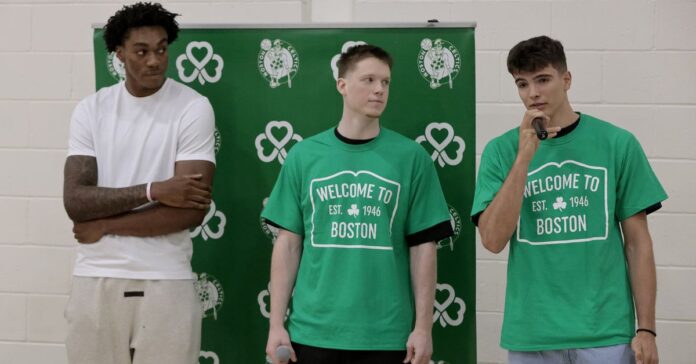I’m a mediocre darts player. There’s very little precision in my gameplay, but after enough attempts, I may luck my way into a bullseye. In a year destined for uncertainty, the Celtics can deploy a similar approach.
Boston is down two of their top three centers, and while Al Horford has yet to make a decision, his departure feels likely as well. The frontcourt has been swiftly dismantled, but on the bright side, this clean break allows the team to pivot into a gap year.
The Celtics still have a lightly traced outline of their championship roster with Jaylen Brown and Derrick White leading the way. However, with a deeply inexperienced center rotation and Jayson Tatum on the sidelines, it’s difficult to see them competing for more than a Play-In spot.
If that’s the case, it would reasonably be in their best interest to prioritize health and development over a few extra wins.
An Eye Toward the Draft
When thinking of a franchise so committed to hanging banners, I hesitate to use the word tank, because it’s a touchy subject and often signals a lost season. But for Boston, there’s a lot that can be accomplished by accepting their fate and increasing their lottery odds.
In practical terms, that means giving young players extended minutes, being cautious with veterans, and not rushing through injuries. While not a full-on implosion, it’s a shift in focus that helps them ease into and navigate a transitional year.
By all accounts, the 2026 NBA Draft class is loaded. There are intriguing returners, and talented incoming freshmen led by a Big Three of Cameron Boozer, Darryn Peterson and AJ Dybantsa. Each of these three is in the mix for the #1 pick and would be a prize in any draft.
If Boston positions themselves to land any of them, it will immediately inject life into the franchise. They would either have an unbelievable trade chip to target an established player, or a dynamic young prospect that can take some of the load off of the current stars.
It’s a similar set of circumstances to the 2019-2020 Golden State Warriors team that in the absence of Steph Curry, finished with 15 wins and the second overall pick after winning 57 games the year before. It’s also a cautionary tale, as the Warriors picked James Wiseman, but this upcoming draft class projects to be far superior.
As we know, the Warriors didn’t take long to return to excellence. It wasn’t because of their high draft pick, but what they did accomplish was identifying a few members of their next championship team in Jordan Poole and Andrew Wiggins. Boston has an opportunity to nail the draft and find contributors in a similar vain.
If the current state of affairs has made anything clear, it’s that team-building needs to prioritize rookie contracts and hidden gems. While the draft offers long-term answers, the more immediate opportunity lies in identifying contributors who are already in the building or just arriving.
See What Sticks
Brad Stevens hasn’t wasted any time taking fliers. Shortly after news broke of Luke Kornet signing with the Spurs, an agreement was announced between the Celtics and Luka Garza. They followed that up by signing another former Timberwolf in Josh Minott.
Earlier in the draft, they selected 19-year-old wing Hugo Gonzalez with their first-round pick, and then a pair of 23-year-olds in the second round with Amari Williams and Max Shulga.
Stevens and the Celtics have already started throwing darts, but they don’t need a bullseye when simply getting on the board will do. Of course, if one of these new additions transforms into a star it would be wonderful, but the bottom line is that they are on the hunt for role players.
The door is also wide open for returning Celtics to break through and establish themselves. Baylor Scheierman, Neemias Queta, Jordan Walsh and a few other returners have a real pathway to minutes that was rarely afforded to them in the past.
Without the added pressure of competing for a championship, Boston can cultivate an environment that is conducive to player development. The key benefit of a gap year is that the Celtics aren’t looking for anyone to build a culture from scratch. They have an identity and shared mindset, simply needing people that can add to it.
If this were a full rebuild, Boston would be searching for stars. Instead, they can spend time learning who fits next to their best players and adds value to the team.
Closing Thoughts
For years, the Celtics have worked hard to establish a connection with their G-League affiliate in Maine. That has resulted in many NBA call-ups, and a development program that prepares players for when they get their chance.
Boston is going to continue to take full advantage of this pipeline in pursuit of contributors, and they’ve already begun to increase their collaboration with the team. Maine’s head coach Tyler Lashbrook has taken a new position in Boston, and his replacement is Phil Pressey.
“Phil is a dedicated coach who has been instrumental in our player development over the last two seasons,” Joe Mazzulla said.
This puts a coach in Maine that knows exactly what the Celtics’ vision is, and allows him to be an important resource in preparing players for the next level. Additionally, Lashbrook can bring over wisdom about managing the development of multiple players at one time.
For the first time in a long time, Boston’s season won’t be defined by their playoff success. They have room to set short-term goals that lead to the construction of a more sustainable and versatile roster. Taking as many fliers as possible on unproven talent is a good place to start.
While next year may be a bit unfamiliar, it’s a step back to move forward with purpose again.






















